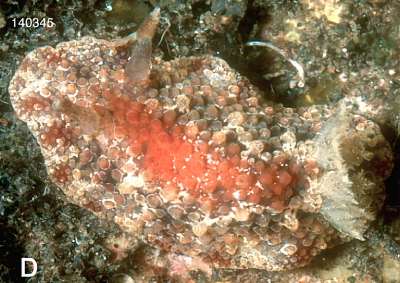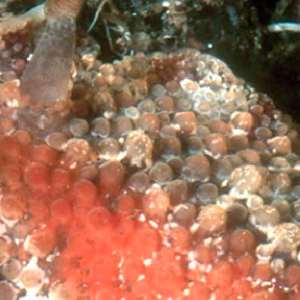

Hoplodoris flammea
Fahey & Gosliner, 2003
Order: NUDIBRANCHIA
Suborder: DORIDINA
Superfamily: EUDORIDOIDEA
Family: Dorididae
DISTRIBUTION
Known only from Bali, Indonesia at present.
PHOTO
Hoplodoris flammea 24 mm long alive. PARATYPE: CASIZ 140345, Tulamben, Bali, Indonesia. 31 October 2000.Photo: T.M. Gosliner. [From Fahey & Gosliner, 2003: Fig 17D]
Hoplodoris flammea has thus far been found only from Bali. It was named for its fiery red central notum color. The notum is covered with large, rounded tubercles and the rhinophores are close-set and tall. The rhinophore and gill sheaths are raised with irregular edges and have small rounded tubercles on the sides and the rim. Hoplodoris flammea is superficially similar to H. bifurcata in that both species have a central dorsum color that is distinct from the surrounding mantle coloration. Hoplodoris flammea has a bright red color, while the central color of H. bifurcata is more reddish-brown. Both species have complex, variegated ground coloration with mottled shades of grays and browns. Both have elongate rhinophores with deep tan lamellar regions and white tips. The gill leaves of both species are feathery and tan in color. But Hoplodoris flammea lacks the small black spots on the notum that are present in H. bifurcata. Further, the internal anatomy, particularly the radular morphology, differs between these species. It is the combination of morphological characters, external, radular and reproductive that distinguishes H. flammea as a separate Hoplodoris species.
Reference:
• Fahey, S. J. & Gosliner, T. M. (2003) Mistaken identities: On the Discodorididae genera Hoplodoris Bergh, 1880 and Carminodoris Bergh, 1889 (Opisthobranchia, Nudibranchia). Proceedings of the California Academy of Sciences, 54(10): 169-208.
Fahey, S. J., 2003 (October 17) Hoplodoris flammea Fahey & Gosliner, 2003. [In] Sea Slug Forum. Australian Museum, Sydney. Available from http://www.seaslugforum.net/find/hoplflam
Related messages
New species of Hoplodoris Bergh, 1880
October 23, 2003
From: Dr Shireen Fahey
Greetings Bill,
Here is some background information on a revision of the dorid genus Hoplodoris Bergh, 1880 that Terry Gosliner and I have just published. The publication (and color photos) can be downloaded at:
http://www.calacademy.org/research/izg/dorids/publications_folder/publications.html
Revision of the genera Hoplodoris Bergh, 1880 and Carminodoris Bergh, 1889
Fahey & Gosliner recently revised the two genera Hoplodoris and Carminodoris due to uncertainty of the phylogenetic status of these two genera. The uncertainty was due to the lack of distinguishing generic features and lack of complete anatomical descriptions. Further anatomical details were revealed during the examination of specimens from the type localities. Analyses indicate that the genus Carminodoris Bergh, 1889 is a junior synonym of Hoplodoris Bergh, 1880. There are few morphological characters that can be used to justify two distinct genera. We reognise the following species:
• Hoplodoris bifurcata (Baba, 1993).
Carminodoris nodulosa from Hawaii and C. bifurcata from Okinawa appear to be the same species and should be called Hoplodoris bifurcata (Baba, 1993).
• Hoplodoris grandiflora (Pease, 1860).
Hoplodoris desmoparypha Bergh, 1880, Carminodoris mauritiana Bergh, 1880 and C. grandiflora (Pease, 1860) are conspecific and should be named Hoplodoris grandiflora (Pease, 1860).
• Hoplodoris nodulosa (Angas, 1864)
Hoplodoris nodulosa (Angas, 1864) and H. novaezelandiae (Bergh, 1904) appear to be conspecific.
• Hoplodoris estrelyado (Gosliner and Behrens, 1998)
Hoplodoris estrelyado (Gosliner and Behrens, 1998) should be retained as valid species.
• Hoplodoris armata (Baba, 1993)
Carminodoris armata Baba, 1993 is a synonym of Hoplodoris armata.
• Hoplodoris flammea Fahey & Gosliner, 2003 [new species]
• Hoplodoris bramale Fahey & Gosliner, 2003 [new species]
Thus, there are seven valid species in the genus Hoplodoris: H. armata, H. bifurcata, H. bramale, H. estrelyado, H. flammea, H. grandiflora and H. nodulosa.
Although the genus Discodoris is a closely related taxon, the genus Geitodoris is more closely related to Hoplodoris. Important diagnostic morphological characters of Hoplodoris that have been inherited from a common ancestor include penial hooks and denticulate radular teeth. Newly acquired morphological characters of Hoplodoris species include an accessory gland with a spine and vaginal armament.
Reference:
• Fahey, S. J. & Gosliner, T. M. (2003) Mistaken identities: On the Discodorididae genera Hoplodoris Bergh, 1880 and Carminodoris Bergh, 1889 (Opisthobranchia, Nudibranchia). Proceedings of the California Academy of Sciences, 54(10): 169-208.
Shireen Fahey
sfahey@calacademy.org
Fahey, S.J., 2003 (Oct 23) New species of Hoplodoris Bergh, 1880. [Message in] Sea Slug Forum. Australian Museum, Sydney. Available from http://www.seaslugforum.net/find/11040Thanks Shireen,
I have added your accounts of the two new species as separate messages, and have added some information and photos from your paper of the other species, so your concept of each species is clear.
Best wishes
Bill Rudman
Information on Hoplodoris flammea
October 23, 2003
From: Dr Shireen Fahey


PHOTO: Hoplodoris flammea 24 mm long alive. PARATYPE: CASIZ 140345, Tulamben, Bali, Indonesia. 31 October 2000.Photo: T.M. Gosliner. [From Fahey & Gosliner, 2003: Fig 17D]
As I mentioned in my message about our generic review, here is a summary of our description of Hoplodoris flammea.
Hoplodoris flammea has thus far been found only from Bali. It was named for its fiery red central notum color. The notum is covered with large, rounded tubercles and the rhinophores are close-set and tall. The rhinophore and gill sheaths are raised with irregular edges and have small rounded tubercles on the sides and the rim. Hoplodoris flammea is superficially similar to H. bifurcata in that both species have a central dorsum color that is distinct from the surrounding mantle coloration. Hoplodoris flammea has a bright red color, while the central color of H. bifurcata is more reddish-brown. Both species have complex, variegated ground coloration with mottled shades of grays and browns. Both have elongate rhinophores with deep tan lamellar regions and white tips. The gill leaves of both species are feathery and tan in color. But Hoplodoris flammea lacks the small black spots on the notum that are present in H. bifurcata. Further, the internal anatomy, particularly the radular morphology, differs between these species. It is the combination of morphological characters, external, radular and reproductive that distinguishes H. flammea as a separate Hoplodoris species.
Reference:
• Fahey, S. J. & Gosliner, T. M. (2003) Mistaken identities: On the Discodorididae genera Hoplodoris Bergh, 1880 and Carminodoris Bergh, 1889 (Opisthobranchia, Nudibranchia). Proceedings of the California Academy of Sciences, 54(10): 169-208.
Dr Shireen Fahey
sfahey@calacademy.org
Fahey, S.J., 2003 (Oct 23) Information on Hoplodoris flammea. [Message in] Sea Slug Forum. Australian Museum, Sydney. Available from http://www.seaslugforum.net/find/11255Thanks Shireen
Bill Rudman
